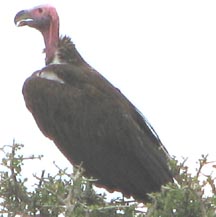Some vultures & buzzards we photographed in East Africa

|
Augur Buzzard
— also known as the African Red-tailed Hawk
— have been seen soaring as high as 17,000 feet
— regularly occur higher than any other bird of prey in Africa
— prey is normally identified from a perch - also hunts in flight
— sibling aggression usually means the youngest of 2 chicks dies
|

|
Black Kite
— highly successful and abundant raptor
— omnivorous and has developed a commensal relationship with man
|

|
Hooded Vulture
— bald head
— likely because a feathered head would become spattered with blood etc.
— they will wait, several days if necessary, until a carnivore leaves a carcass
— they have backward-facing spines on the tongue to help remove meat from bone
|

|
Rüppell's Vulture
— highly social
— roost until 2 hours after sun-rise
— fly when enough thermal currents to provide lift
— named for the 19th century German explorer, collector and zoologist Eduard Rüppell
|

|
White-backed Vulture
— scavenger birds
— will devour until can hardly fly
— they feed mostly on the carcasses of dead animals
— Old World vultures find carcasses exclusively by sight
|
|
 |